Category: Air National Guard
We owe him everything we’ve got… and then some.
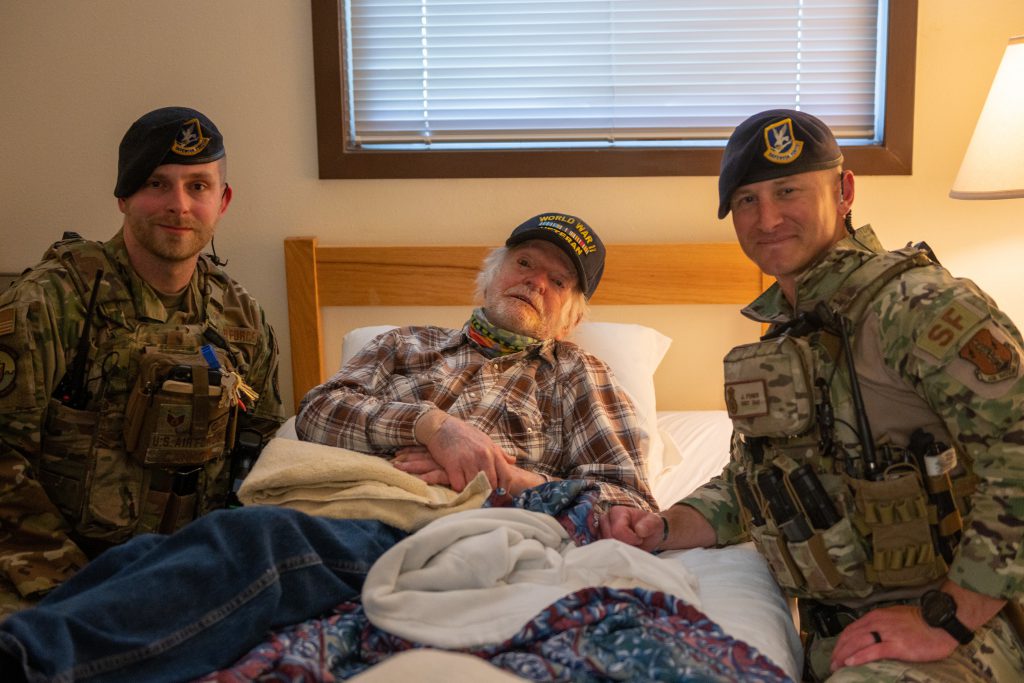
124th Fighter Wing Public Affairs/Staff. Sgt. Mercedee Wilds
124th Security Forces Squadron defenders went above and beyond to assist a 96-year-old World War II veteran.
Retired Capt. William Brand was a P-47 Thunderbolt pilot with the Eighth Air Force in Okinawa, Japan, during WWII. He now lives in Hailey, Idaho, but regularly travels to Gowen Field in Boise, Idaho to stay at the on-base lodging on days that he has appointments at the Boise VA Medical Center.
On May 6, 2021, 124th SFS defenders received an emergency call to the Gowen Field Lodging Facility. As Brand was checking in for a routine stay at the Gowen Field Lodging Facility he experienced a medical emergency, which left this WWII veteran with special requirements and a limited ability to properly care for himself and coordinate his VA appointments.
124th SFS defenders took it upon themselves to organize hourly shifts to check on the well-being of Brand, which included assisting with tasks of daily-living, providing essential needs and helping to coordinate with the VA for medical attention.
The defenders took on the role of dedicated care-givers, going beyond their typical duty and surpassing their daily requirements. To this group of 124th SFS members, it was an honor to help Brand and learn about his service to our country.
“Helping a veteran isn’t in our book for normal tasks, but it’s a sense of honor to help someone like that, who not only served our country but spent time in a war that we are still benefiting from,” said Staff Sgt. Jonathan Finer, a 124th SFS member.
Finer and the other defenders who helped Brand felt providing help and assistance to him, a brother in arms who dedicated so much of his life to protecting our country, was the least they could do.
“It’s an honor to be able to hear the stories from the direct mouth of someone who has experienced it,” said Finer, “my personal feelings are that we owe him everything we’ve got and then some.”
Idaho Guard partners in multi-agency all-hazards exercise
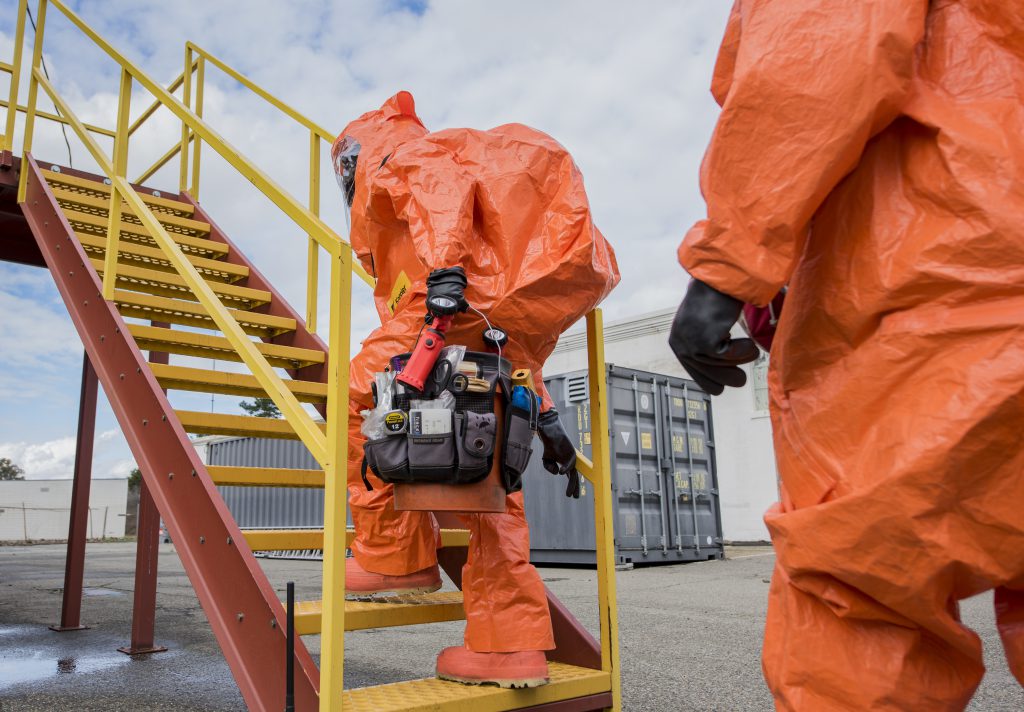
Crystal Farris/Idaho Military Division Public Affairs
The Idaho National Guard’s 101st Weapons of Mass Destruction Civil Support Team partnered with CSTs from 11 other states, along with more than ten different local and federal agencies and organizations, during Exercise ORCA 2021, to train in responding to various hazardous material incidents throughout Alaska, May 17 to 20.
The all-hazards exercise that took place simultaneously in Anchorage, Matanuska-Susitna Valley and Seward, involved the largest turnout of CST participants to an ORCA exercise, helping the 101st CST and other emergency responders maximize training opportunities while testing interagency coordination, interoperability and response abilities.
“It is important that we practice deployment operations and integration with other teams through exercises to ensure a rapid, timely and integrated response to a real-world threat,” said Capt. Jessica McBride, 101st CST survey team leader.
During the exercise, CSTs coordinated and worked through various scenarios, including identifying illicit and dangerous substances and responding to simulated attacks and disasters.
The 101st CST responded to the Anchorage Fire Training Center, which for the exercise simulated a residential six-story apartment building with approximately 20 rooms where terrorists prepared weapons of mass destruction.
“We were called in to conduct a relief-in-place of Alaska’s 103rd CST after it established perimeters with safe zones and threat zones, and then started site characterization of the building itself,” said Capt. John Bomsta, 101st CST operations officer. “We assisted in finishing the site characterization, describing what the building looked like and the possible threats we found. There was something to be found in every room and a lot of area to cover.”
Once on scene, the 101st CST worked through the night for approximately 12 hours continuing site characterization and field analysis of the building. During that time, it located five lab setups including a drug lab, a homemade explosives lab and a potential nerve agent lab. Rooms also had trips wires, motion detectors and confined spaces.
“We were able to provide field analysis of what we saw in the building in order to push information up to higher, which in this case was the FBI as incident command, on what they should look for at other sites,” said Bomsta. “As the story developed, other CSTs were located as far south as Seward, also responding to various terrorist threats in their vicinities.”
CSTs from Alaska, California, Connecticut, Colorado, Ohio, Oregon, Rhode Island, South Carolina, South Dakota, Washington and Wisconsin attended, in addition to other National Guard units such as Colorado’s 8th CBRN Enhanced Response Force-Package and members of Alaska’s 176th Civil Engineer Squadron.
Local agencies and organizations included Alaska Department of Homeland Security and Emergency Management, Matanuska-Susitna Emergency Management, Alaska Department of Environmental Conservation, Major Marine Tours, Alaska Railroad, Anchorage Fire Department, Alaska State Emergency Operations Center, University of Alaska-Anchorage, Port of Seward and the Port of Alaska-Anchorage.
“The exercise was designed with scenarios based on what all the participating CSTs had communicated they wanted to see and tasks they wanted to accomplish,” said Maj. Robert Grimes, 101st CST commander. “Our team was able to achieve various objectives, including integrating with other CSTs and civil responders to build those relationships and learn each other’s capabilities and limitations.”
Unlike most other military units, CSTs work almost entirely alongside civilian agencies, including regional hazardous response teams, police, firefighters and other state or federal responders that function under an incident command system during emergency situations. Grimes said developing these partnerships make training scenarios like Exercise ORCA 2021 critically important.
“What we do as an individual team is just one portion of what it takes overall to respond to a real-world event like this,” said Grimes. “We train to provide the best support we can to civil authorities in the event of a domestic chemical, biological, radiological or nuclear high-yield explosives incident.”
As one of 57 teams located in every U.S. state and territory, the 101st CST is composed of 22 highly skilled full-time Army and Air National Guardsmen trained to provide incident and disaster management by identifying CBRNE agents and substances, assessing current or projected consequences, advising on response measures and assisting with appropriate request for additional follow-on state and federal military forces.
As part of Idaho’s emergency response structure, the unit is prepared and ready to respond at any time to hazardous incidents that threaten the community, state and nation and are often called upon state-side to assist in public safety events including sports games and governor inaugurations.
From the ground to the sky: Idaho’s joint fire exercise
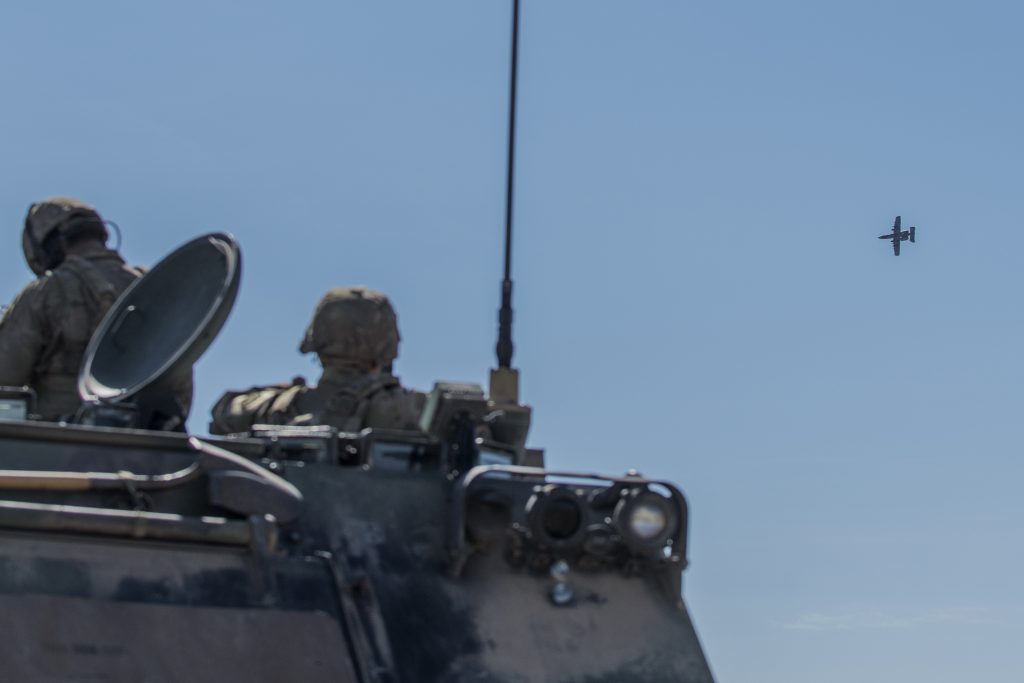
Master Sgt. Becky Vanshur/Idaho Military Division Public Affairs
Idaho citizen-Soldiers and Airmen trained together May 18-19 to support a joint fire exercise that combined live mortars from the ground with close air support from above. Included were live bombs, missiles and combined effects munitions at Idaho’s premier training location, the Orchard Combat Training Center.
The Idaho Army National Guard’s 2nd of the 116th Combined Arms Battalion and the Idaho Air National Guard’s 124th Air Support Operations Squadron and 190th Fighter Squadron joined forces from the ground to the sky in the large-scale joint training event.
“Our battalion hasn’t had this level of training or this level of interoperability working with the Air Force before,” said Maj. John Gregory, 2-116 CAB operations officer. “We want to get to that level of proficiency working with each other, Army and Air, and provide ourselves the most lethal amount of force and mass effects in one space, at one time.”
Integrating the Idaho Air National Guard to bring combined effects on the battlespace started two years ago with dry run munitions. This year the exercise combined live munitions. 124th ASOS joint terminal attack controllers worked with the 2-116 CAB’s joint fire observers to direct targets with combined live-fire weapons engagement.
Idaho’s A-10 Thunderbolt II aircraft dropped 500-pound bombs and other munitions in close air support for a combined effect after the ground forces engaged with the 120-millimeter self-propelled mortar explosives. This is the first time the A-10s dropped the live bombs at the OCTC as airpower support for the Idaho Army National Guard.
“Joint live-fire integration is the key to success on the battlefield of tomorrow,” said Brig. Gen. Timothy Donnellan, Assistant Adjutant General – Air. “The Soldiers and Airmen of the Idaho National Guard will continue to train together following the National Defense Strategy. The live-fire integration training conducted will give the ground commander the confidence they need to dominate the battlespace of the future aggressively.”
A variety of weapon platforms and munitions are used to attack enemy air defenses through the U.S. Department of Defense’s concept of suppression of the enemy air defense, or SEAD mission.
“We want to build on this training and make it a grander concept over the years to come,” said Capt. Jacob Bartlow, 2-116 CAB assistant operations officer. “We settled on a concept of the SEAD mission. This training turned out to be a great run and integrated all three units.”
The training will continue to become more robust each year. Bartlow plans to have several iterations of close air support from the A-10s in the future and possibly integrate F-15s from Mountain Home Air Force Base to support SEAD.
“In future joint fire exercises at the OCTC, we can include scouts to identify the enemy, bring in artillery, mortars and air defense to suppress the capabilities of the enemy so we can free the maneuver in another portion of the battlespace,” said Bartlow.
Located 18 miles south of Boise, Idaho’s OCTC has 143,000 acres of vast terrain and world-class ranges with a four-season climate, making it ideal for preparing units for combat in a challenging and realistic training environment.
“We have incredible training space here at the OCTC,” said Bartlow. “Ultimately, we envision Idaho as the National Guard’s premier location for joint fire integration.”
Siblings serve in Idaho Guard as Citizen-Soldier, Airman
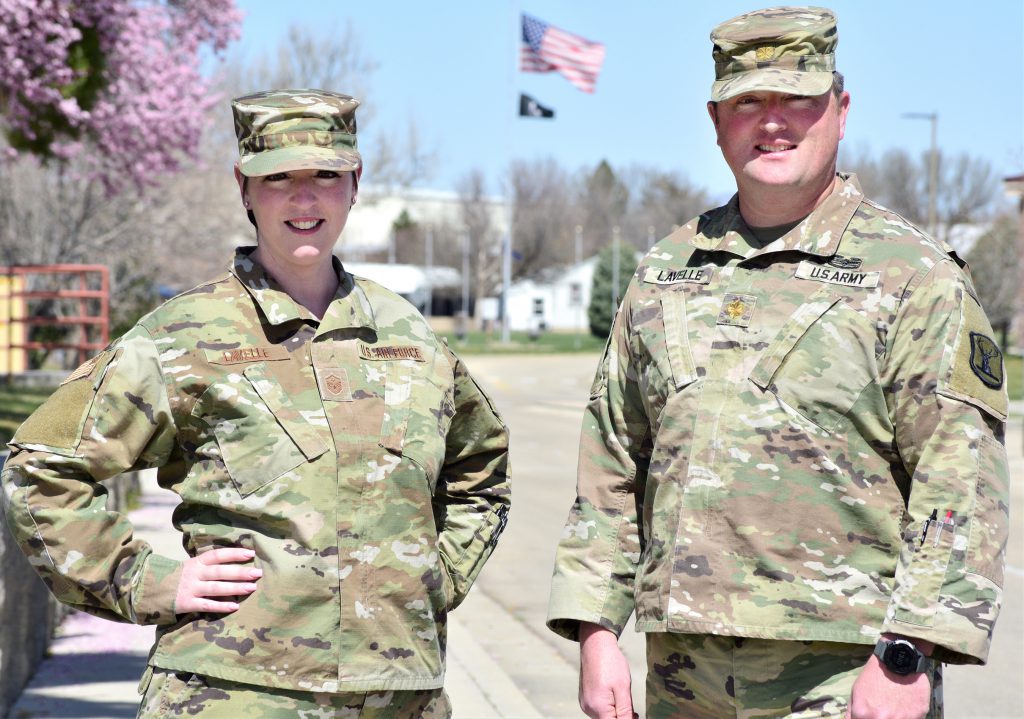
By Crystal Farris/Idaho Military Division Public Affairs
Maj. Christopher Lavelle and his younger sister, Master Sgt. Kerry Lavelle, are known on Gowen Field as “the Lavelles.” They have served on base as full-time technicians for several years and as traditional Guardsmen in the Idaho National Guard for nearly 20 years.
“It’s been fun serving in the military at the same time as my family,” said Christopher. “It seemed at one point that everyone on base knew who we were. They would see Kerry when she used to work in security forces at the front gate and they would see me for computer problems at the communications office.”
Joining the Guard was not something they planned to do together but was something they both ended up doing to pay for school. Coming from a family with four other siblings, Christopher said his dad could not afford to send them all to college. Serving in the military was a way to receive education assistance.
“Kerry and I weren’t confident in what we wanted to do in our lives or how long we would stay in the military,” he said. “We both ended up serving almost 20 years and having successful careers within the Guard.”
“I joined to pay for school, but I chose the Air Guard because my brother was in the Army Guard,” Kerry said. “I couldn’t join the same branch as him; I had to do something different.”
Christopher enlisted into the Idaho Army National Guard in June 2000 as a signal operations specialist after graduating from high school in Boise. A year later, Kerry graduated from the same high school and enlisted into the Idaho Air National Guard as a security forces Airman.
After returning from training at Fort Benning, Georgia, Christopher deployed to Bosnia with the 183rd Aviation Regiment in 2002. He later joined the 116th Cavalry Brigade Combat Team and deployed to Iraq in 2004. The next year, he reenlisted and started work as a full-time technician for the Idaho Army National Guard.
He served nine years as an enlisted Guardsman, became a sergeant, enrolled in officer candidate school and commissioned as a signal officer in 2008. The same year, Christopher earned bachelor’s degrees in criminal justice and political science from Boise State University.
“It took a long time for me to finish school between two deployments,” said Christopher. “I reenlisted because I wasn’t done with what I started and wanted to complete school. I later decided that if I was going to stay in, I wanted to commission.”
Kerry and her younger sister, Caitlin, who also served in the Idaho Army National Guard from 2004 to 2011, attended Christopher’s commissioning ceremony on Gowen Field.
“We were really proud of him,” Kerry said. “We both raced to the stage wanting to be the first to salute him, but Caitlin pulled off my hat to slow me down and ended up winning.”
In 2010, Christopher deployed again to Iraq as a platoon leader with the 148th Field Artillery Battalion. Since returning, he has served in various positions in the Guard, including company commander and signal officer for both a battalion and brigade staff.
He now works as a full-time technician and data processing manager for the United States Property and Fiscal Office and serves part time as a traditional Guardsman and the staff communications officer for Joint Force Headquarters-Idaho.
When Kerry went to Lackland Air Force Base in San Antonio, Texas, for basic military training in 2002, Christopher stayed in touch through letters.
“I remember my brother sent me postcards and pictures,” Kerry recalled. “He was in Salt Lake doing security for the Olympics and sent me a picture of him standing on his bunk with the bed all messed up. He joked, ‘How is basic training going? Good thing you are learning how to make a bed.'”
Kerry returned home in June 2002 and was activated, along with most of the 124th Security Forces Squadron, to provide increased security on Gowen Field after 9/11. She attended school and served intermittently on active duty orders as part of security forces on Gowen Field and Mountain Home Air Force Base until reenlisting in 2007.
“I decided last minute to stay in because the military was the one consistent thing in my life,” said Kerry. “I figured it would be a good decision, and it was.”
Kerry deployed to Saudi Arabia for six months with the 124th Security Forces Squadron in 2008. In 2010, she earned a social sciences degree in general studies from Boise State University and three years later left for Korea.
“I wanted to do something different just for a little while,” said Kerry. “I decided to travel to Korea and teach English for two years. It was fabulous. I also met my husband there, who laughs when I tell people he’s my favorite souvenir.”
Kerry returned home in 2015 and continued work in security forces until becoming the first sergeant for the wing’s logistics readiness squadron in 2018. That same year, she started a full-time job at the Department of Veterans Affairs. In 2019, Kerry reenlisted for the second time in a ceremony on Gowen Field. Christopher read her oath of reenlistment.
“It was really cool that Christopher was able to reenlist me,” said Kerry. “It makes me laugh thinking about how I messed up the oath because he had given me too many words at one time to repeat from memory.”
Although the two siblings are only 15 months apart, Kerry said Christopher took on fatherly responsibilities at a young age while their father was sick and after he died in 2008.
“My brother has taken on a different role in our family to all of us as kind of a caretaker,” said Kerry. “I’m sure at some point, my dad pulled him aside and told him to look after his family.”
While their father was sick with cancer, Christopher said they had many heart-to-hearts, mostly about taking care of the family.
“He had a big concern for his family and wanted the best for his kids,” said Christopher. “Out of five of us, three joined the military and two are still in. My other sisters also work in public service, so I think we have all done really well, and I know my dad would be proud of us.”
Kerry works in employee labor relations at the VA’s human resources office. In December, she became the first sergeant for the 124th Fighter Wing staff.
Airman serves as Guard flight surgeon, civilian physician
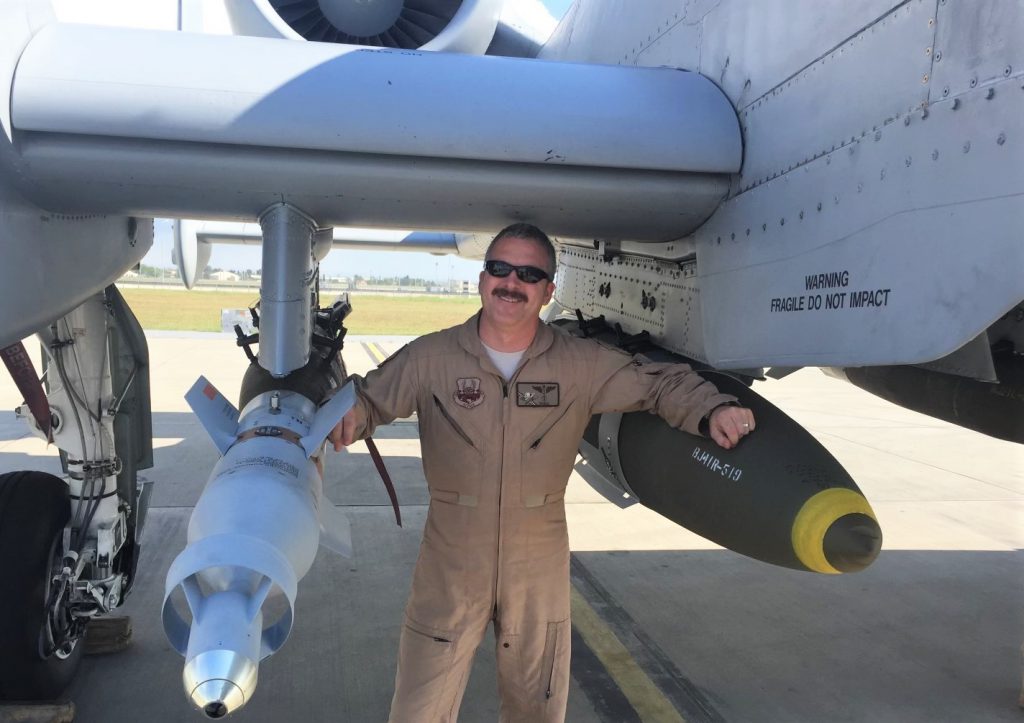
When he was in high school, Lt. Col. Timothy Ruth attended a science exhibition with his parents at a local museum in Minnesota. There was an educational video of an open-heart surgical procedure playing in one of the exhibits. The sight of the video nearly made him ill.
“My mom jokes about how I almost got sick watching it,” said Ruth. “My parents were a bit surprised when I later told them I wanted to go to medical school.”
Ruth was not surprised, however, since his interest in medicine had sparked earlier as a young kid assisting in surgeries and other pet care from his dad’s veterinary practice in their Pennsylvanian home.
He said the act of performing medical tasks was easier for him then just watching them. He also enjoyed the challenge of the field and helping others.
“It seemed to be the perfect career for me,” said Ruth. “Being a doctor meant I got to help people by using what I’ve learned, talents I have and gifts I’ve been given.”
After four years of college, four years of medical school and three years of residency, Ruth became a family practice physician.
Today he serves as a tradition Guardsman and flight surgeon for the 124th Fighter Wing’s 190th Fighter Squadron. He also works full-time as an urgent care provider and senior Federal Aviation Administration examiner for St. Luke’s hospital in Boise, Idaho.
Military first, medical school second
Joining the military was something Ruth wanted to do before he ever considered being a physician. Getting to do both was just the icing on the cake, he said.
After moving from Pennsylvania where he was born, to Minnesota where he graduating high school, Ruth joined the College of St. Thomas’ Air Force ROTC Program in St. Paul.
“I think I always had an interest in the military that started with talking to my grandfather who served as a Seabee in the Navy during World War II,” said Ruth. “It just so happened my college had ROTC, which interested me because it allowed me to try out the military before committing to it.”
Ruth graduated with a bachelor’s in chemistry and a minor in aerospace studies, while also commissioning into the active Air Force as a second lieutenant in 1993. He was then accepted to medical school at the Medical College of Wisconsin, where he received a full scholarship under the Health Profession Scholarship Program.
After medical school, Ruth continued onto his residency at the University of Wisconsin where he specialized in family medicine before starting his eight-year active duty commitment.
In 2000, he received his first duty assignment as a family physician at Grand Forks Air Force Base in North Dakota. Three years later he transferred to Mountain Home Air Force Base in Idaho where he continued to serve in family medicine before attending flight surgeon school and switching to flight medicine in 2004.
The ‘flight physician’
Despite the name, flight surgeons do not perform surgery and do not have to be surgeons. Rather they tend to be physicians of family medicine, emergency medicine, internal medicine or something broader, Ruth said.
Their duties include conducting flight physicals, reviewing medical records, performing physical exams, inspecting work place safety hazards and collaborating with various occupational health programs to maintain the overall flight safety and safety of the organization’s pilots.
“Contrary to the name, you aren’t doing surgery on anyone much less in the air,” said Ruth. “You are a physician and your job is flight safety and taking care of the flyers. A better name for it would be flight physician.”
Since flight surgeons are rated officers and required to perform flying duties, they go through similar survival training as pilots, including water survival, egress and hypoxia chamber training. Going through these types of training, as well as flying with the pilots, give flight surgeons the ability to provide adequate care in their unique situation, Ruth said.
“The medicine that you practice and the things that happen to people at 1g on the ground are very different then what happens to the human body at 9gs,” he said. “When you fly with them, you understand all the physical and physiological demands placed on their bodies.”
After serving another five years in the Air Force, deploying to Ecuador in 2004 and to Afghanistan in 2007 with the 366th Fighter Wing, Ruth left the military completely. The day after he got out and was hanging up his flight suit, Ruth said he had a change of heart and decided to join the Idaho Air National Guard in 2008.
Not ready to hang up his flight suit
“I just wasn’t ready to walk away from that whole unique experience of flight medicine and military comradery,” said Ruth. “Military medicine offers some very unique opportunities that civilian medicine does not, like getting to participate in the whole flying world.”
As a flight surgeon with the Idaho Air National Guard, Ruth collaborates with the organization’s medical group to maintain the flight safety and medical readiness of approximately 50 pilots who fly the A-10 Thunderbolt.
The medical group consists of approximately 80 enlisted and commissioned Airmen who serve as physicians, advanced practice providers, nurses, ER doctors, surgeons and medical technicians. Some serve as ground surgical teams and critical air transport teams, while all are responsible for maintaining the medical readiness of the Idaho Air National Guard’s approximately 2,000 Airmen.
When not serving in the military, many of the Guardsmen work in similar civilian jobs within the medical field like he does, Ruth said. Being able to pursue a civilian career while also serving close to home makes the Guard more appealing then active duty, he added.
“It’s an amazingly diverse group of people,” said Ruth. “All of these Airmen on the civilian side work in everything from ER doctors and cardiothoracic surgeons to fire fighters and police officers. That’s the nice thing about the Guard, you get to do your civilian job but still get to be part of the military. That’s what appeals to me most.”
A civilian physician
On the civilian side, Ruth has worked as a family physician for St. Luke’s since 2008. He currently serves as the director of its urgent care facility in Boise, where he practices urgent care and treats patients with a variety of issues.
“I like the challenge,” said Ruth. “Every person that comes in has a unique challenge or circumstance and if you have the skills to help them it’s very gratifying.”
Within the same facility, Ruth also conducts Federal Aviation Administration examinations for private and commercial pilots who need to recertify their medical credentialing. Like the medical group, many of the Idaho Air National Guard’s pilots also work in similar civilian jobs and fly outside of the Guard.
Ruth said he enjoys getting the opportunity to serve his fellow Airmen and friends on the civilian side, as well as on the military side.
“Most of my friends are pilots and I enjoy having the ability to help them with their annual FAA examinations,” said Ruth. “Civilian FAA exams are similar to military flight exams so it’s a pretty natural bridge from flight surgeon to FAA examiner.”
Last year while deployed to Bagram Air Force Base in Afghanistan, Ruth had the opportunity to use his FAA credentialing to administer examinations to approximately 40 civilian pilots who were unable to return home due to the COVID-19 pandemic and needed to update their medical records.
“It was not something I had imagined doing on a deployment but I was able do that for those people and save them a big hassle in the end,” said Ruth. “It’s just another example of the unique opportunities medical providers get to experience through the Guard while serving others.”
IDAHO NATIONAL GUARD SENDS PERSONNEL TO WASHINGTON, D.C. TO ASSIST 59TH PRESIDENTIAL INAUGURATION
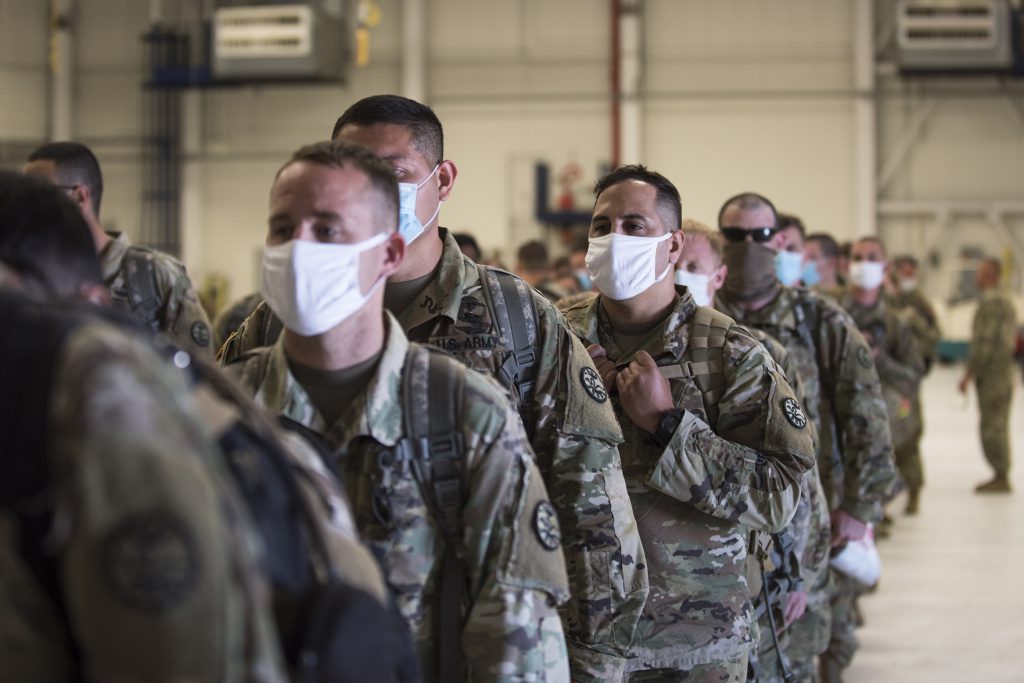
Idaho Military Division Public Affairs
(GOWEN FIELD) — The Idaho National Guard will send approximately 300 Soldiers and Airmen to Washington, D.C. in the coming days to assist district and federal agencies with the presidential inauguration. These Guardsmen will augment the Washington D.C. National Guard and serve in support of the U.S. Secret Service, the lead federal agency responsible for coordinating the event.
Personnel will begin departing from Gowen Field in Boise less than 72 hours after Gov. Brad Little approved the mission. The Nation’s Guard response could include an estimated 25,000 Guard members from all states and territories.
“The National Guard has participated in every presidential inauguration in our nation’s history,” said Maj. Gen. Michael Garshak, adjutant general of Idaho. “It is an honor to be a part of the tradition of ensuring the peaceful and orderly transition of national power; an act that separates us from many other countries across the world.”
Guardsmen will travel to Washington, D.C. via military airlift and contracted aircraft with standard government-issued equipment to perform a number of potential tasks to include security, communications, medical, logistics, and safety support to district and federal agencies. Nearly half of the National Guard task force will conduct security-related duties to include traffic control or by assisting visitors to proper assembly locations as well as entry and exit points.
The Idaho National Guard has planned for more than a month to send roughly a dozen personnel to the region in support of the inauguration. The increase in personnel is part of a new request to provide additional Guard support and represents roughly six percent of the Idaho National Guard force.
This deployment does not involve Soldiers and Airmen already working in their communities as part of the COVID-19 response effort. The Idaho National Guard will continue to maintain its capacity to provide emergency response in Idaho, whether it be a COVID surge, civil unrest, natural disaster or other emergency response function.
The Idaho National Guard has deployed out of state in support of national emergencies in the past. From Hurricane Katrina in 2005, wildland fire suppression in Oregon and Washington in 2015, to Puerto Rico for Hurricane Maria recovery support in 2017, the Idaho National Guard has provided hundreds of Soldiers and Airmen over the last decade in response to national emergencies.
More recently, last summer the Idaho National Guard sent Soldiers and helicopters to fight California wildfires and more than 400 Soldiers to Washington, D.C. to assist with civil unrest response. Additionally, the Idaho National Guard continues to provide state emergency relief here at home during the COVID-19 pandemic.
Idaho Senior Enlisted Leader does more than horse around
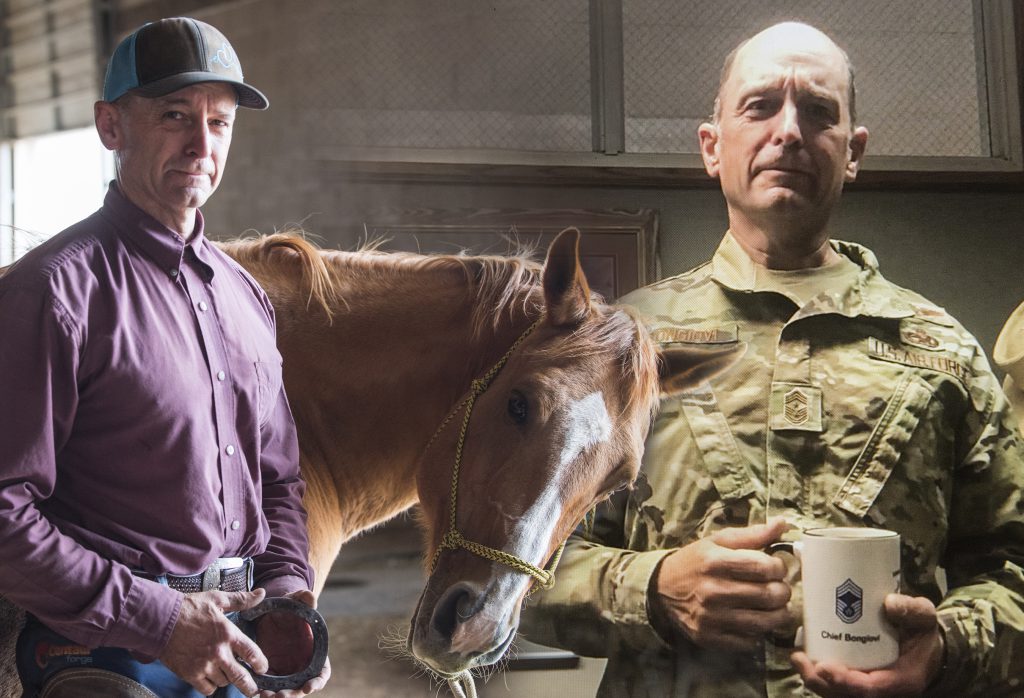
Chief Master Sgt. Harold Bongiovi sees a lot of similarities between working with horses and working with the Soldiers and Airmen he oversees as the Idaho National Guard’s senior enlisted leader.
Bongiovi spends his days around horses. He grew up around them. He trains a few, but most of his time is spent working as a farrier, someone who specializes in horseshoeing. Because every horse’s hoof is different, each shoe must be pre-made or shaped to that specific horse, similar to the personalities of each Soldier and Airman.
“Horsemanship skills are similar to leadership skills,” he said. “The language is different, but it’s the same theory. Horses look for leadership capabilities from the people they are around just like people do. They just speak a different language. They respond to good quality leadership and they resent hard-handed leadership, just like people.”
Bongiovi spends at least one day a week and one weekend a month working alongside Maj. Gen. Michael Garshak, adjutant general of Idaho and the commander of the Idaho National Guard. Bongiovi credits the balance he finds between his military and civilian careers with prolonging both.
“Over the years, I’ve liked being able to do something different,” he said. “The opportunities I’ve had in the military sure beat shoeing horses six days a week, 52 weeks a year.”
Bongiovi estimates that the weekly break has added another four or five years to his horseshoeing career, which began on his grandfather’s farm. Bongiovi grew up there and his grandfather always had horses.
“I had the bug when I was a kid and there’s no cure,” he said.
When Bongiovi was 16, he needed someone to shoe one of his horses but couldn’t find anyone to do it so he decided to figure it out himself. His neighbors asked him to shoe their horses. Then their neighbors told their neighbors they knew someone who could shoe horses. By 17, Bongiovi realized he could make money shoeing horses.
Bongiovi joined the United States Air Force in 1985 to go to college. However, he realized he wasn’t able to attend classes due to his travel schedule as a KC-135 crew chief. After four years, he got out of the Air Force and moved back to Idaho without intending to continue his military career.
In 1989, he joined the Idaho Air National Guard’s 124th Fighter Wing.
“I started thinking, ‘I have all this experience, maybe I shouldn’t let it go to waste.’”
He was hired into a full-time position shortly after but in 1996, his part-time horseshoeing business started to take off so he decided to become a part-time Guardsman.
Bongiovi said he wouldn’t have gotten to travel as much as he has without the National Guard experience. In addition, he said being a traditional Guardsman keeps him fresh because he’s able to take a break from a problem and approach it again with a fresh set of eyes.
Bongiovi was appointed as the state enlisted leader in 2017 and is the second Airman to hold the position. As the state’s senior enlisted member, he communicates directly to the state’s commanding general on behalf of the Idaho National Guard’s enlisted members.
He also helps interpret policy from the National Guard Bureau for implementation across the Idaho National Guard, while also keeping the adjutant general apprised of current issues affecting enlisted personnel.
Idaho National Guard’s 266th Range Squadron deploys to the U.K.
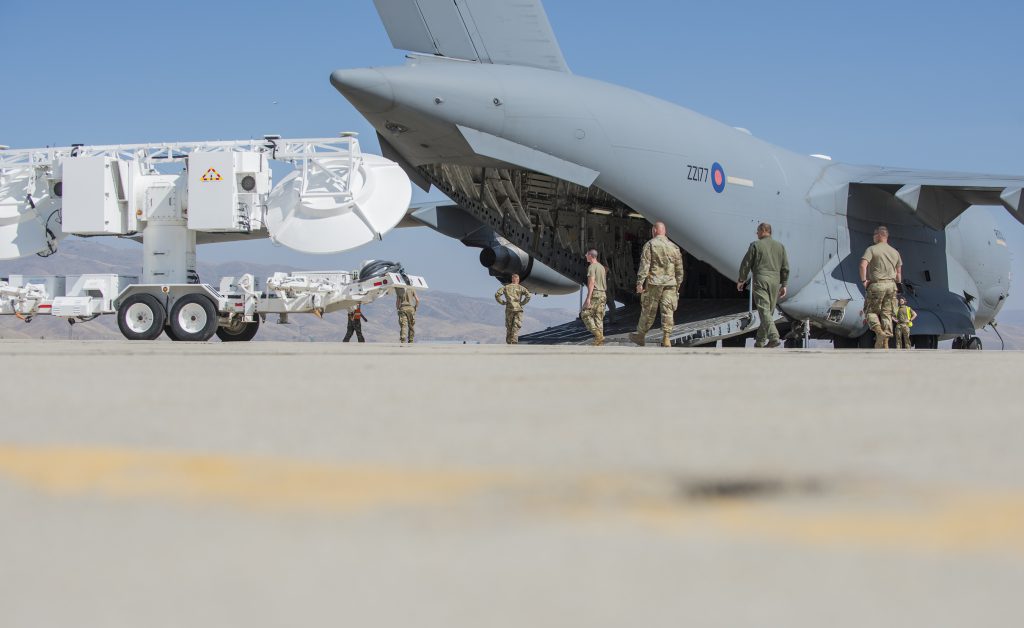
Several Airmen from the Idaho Air National Guard’s 266th Range Squadron and their specialized Joint Threat Emitter equipment deployed this week to Scotland, United Kingdom, after being specifically requested by the No. 11 Group Royal Air Force to support them in numerous joint exercises for the next couple months during the unit’s Carrier Strike Group deployment.
“This is just another example of the capability and flexibility of today’s Idaho National Guard Airmen,” said Brig. Gen. Tim Donnellan, commander, Idaho Air National Guard. “The expertise of what these Airmen are able to provide with their knowledge of the emitter equipment is directly in line with our National Defense Strategy in preparing for future conflicts, and truly shows their commitment and professionalism.”
Idaho’s 226th RANS possesses highly sought-after electronic warfare training capabilities due to the specialized Threat Emitter Units. The IDANG sent two four-person teams with two Joint Threat Emitters to the U.K. on Royal Air Force C-17 Globemaster transport aircraft.
“We are one of the only military units that has the Joint Threat Emitter equipment,” said Tech. Sgt. Phillip Mason from the 266th RANS. “We have the most experience operating and maintaining this equipment, therefore, we get a lot of requests to bring the emitters to a number of exercises around the world.”
The equipment emits radar signals, acting as opposing forces, to pilots flying aircraft in the sky above. The equipment provides scenarios in which pilots can react to threats they may face in real-world situations.
“That’s what makes this training great for pilots,“ said Mason. “In the real-world they will be able to recognize that signal after training with this equipment and avoid being shot down.”
This training will help U.K. pilots achieve high-end collective training objectives during the Carrier Strike Group exercises. Additionally, U.S. Marine Corps ground troops are participating in the deployment and will provide a joint capability training opportunity.
“I am incredibly proud to serve with the Airmen of the IDANG,” said Donnellan. “They always answer the call, even if takes them near the top of the world to Scotland, our Airmen are ready to go. It’s humbling and awe inspiring.”
Join us for our Gowen Field Memorial Park brick laying dedication video
IDAHO AIR NATIONAL GUARD’S 124TH FIGHTER WING DEPLOYS TO SOUTHWEST ASIA
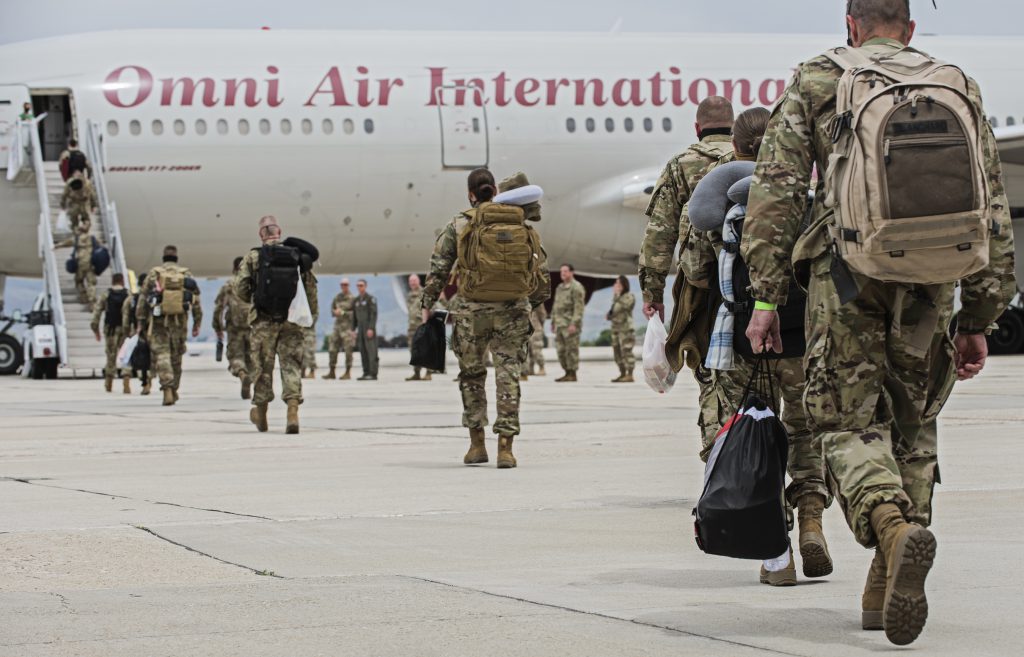
The Idaho Air National Guard deployed to various locations throughout Southwest Asia in support of combat operations on May 11.
More than 400 members of the 124th Fighter Wing, based at Gowen Field, will continue to deploy throughout the spring and summer in support of Operations FREEDOM’S SENTINEL, INHERENT RESOLVE and NEW NORMAL.
“We recognize the impact this mission will have on our community and we deeply appreciate the sacrifice of Idaho’s service members,” Idaho Gov. Brad Little said. “This deployment once again displays the commitment of the 124th Fighter Wing and its members, as well as the dedication demonstrated by the community of families, state and local leaders, neighbors and employers who provide unwavering support to our service members.”
The deployment is the wing’s second largest deployment and includes multiple aircraft, pilots, security forces, maintenance and medical personnel, and various other support staff. The official sendoff took place May 11 with the departure of the main body of personnel.
Deploying Airmen received farewell comments from Idaho National Guard leadership, including Little, Idaho’s commander in chief, and the Adjutant General of Idaho Maj. Gen. Michael Garshak.
Since 1946 the Idaho Air National Guard has flown fighter aircraft in the defense of our nation. The last large scale deployment in the 124th Fighter Wing was in 2016 in support of combat operations against ISIS and it was the largest deployment in the wing’s history. Deployments typically last up to 180 days and impact not only the families of Airmen, but the community as a whole.
 Official Government Website
Official Government Website